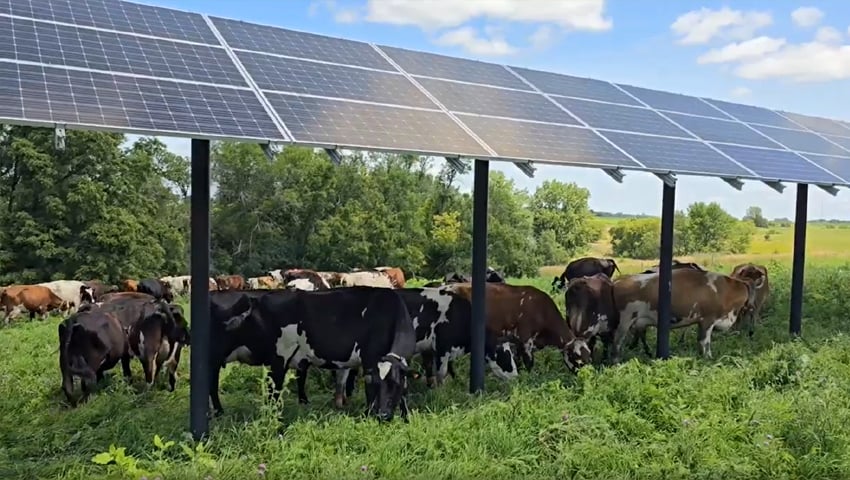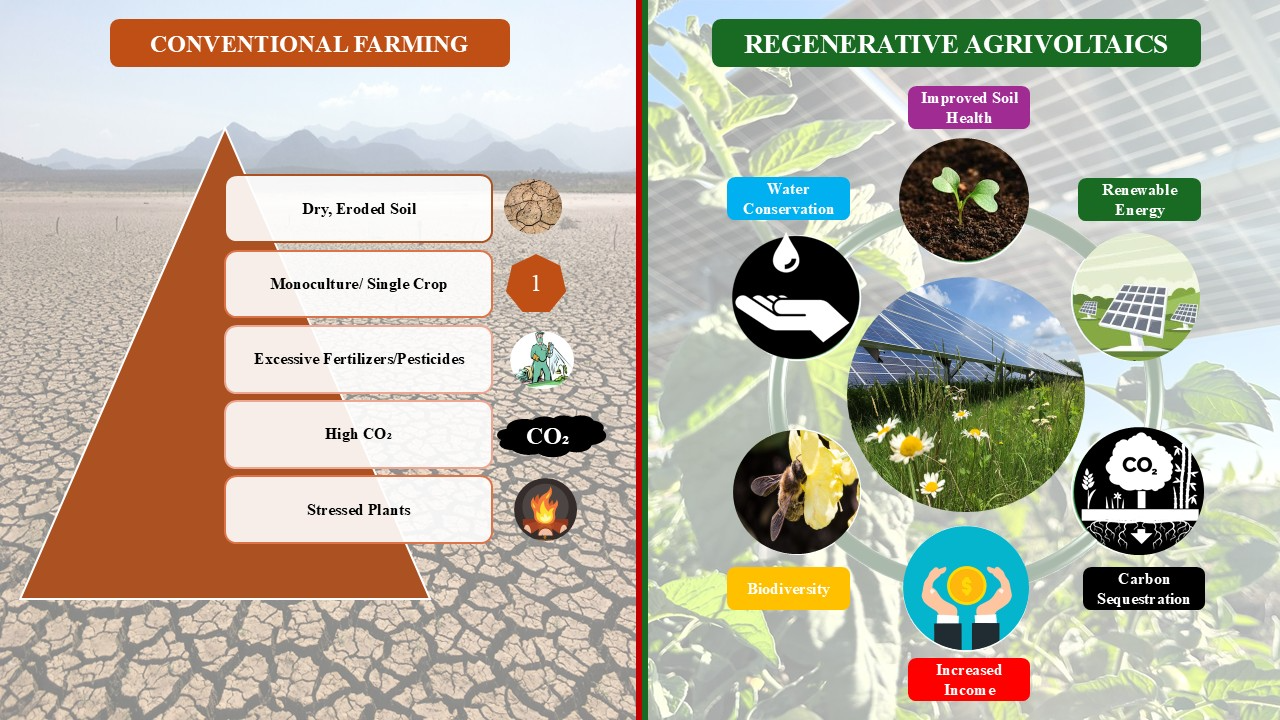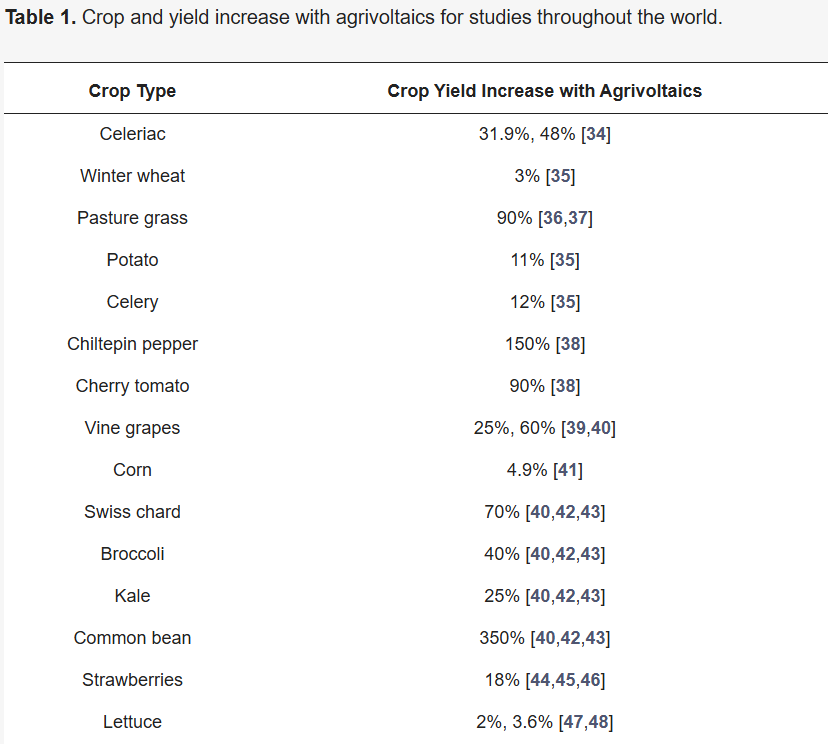Sep 11, 2025
Regenerative Agrivoltaics: Growing Food and Energy Together 🌱☀️

Image source: https://8point9.com/
By Agritecture Team
As the world faces increasing pressure to produce more food while cutting greenhouse gas emissions, agrivoltaics—the dual use of land for solar energy and agriculture—offers a solution that bridges both needs. A recent article by Uzair Jamil and Joshua Pearce in Sustainability (MDPI, 2025) highlights how agrivoltaics, when combined with regenerative agriculture practices, can transform farmland into highly productive, climate-resilient systems.
In this blog, we unpack the key insights from this research and explain what it means for farmers, agronomists, and policymakers considering agrivoltaics.
What Is Regenerative Agrivoltaics?
At its core, regenerative agrivoltaics integrates:
- Solar photovoltaics (PV): producing clean energy directly on farmland
- Regenerative agriculture: practices like cover cropping, reduced tillage, managed grazing, and biodiversity planting that restore soil health and ecosystem function
By stacking these systems, farmers can generate renewable electricity without sacrificing yields—and in many cases, actually boosting productivity.

Key Benefits Backed by Research
🌱 Soil Health and Fertility
- PV shading improved soil quality by increasing microbial activity and nutrient cycling.
- Studies show significant gains in nitrates (up to 8× higher) and potassium (+30%) under solar panels.
- Intercropping peanuts and ryegrass under PV arrays boosted soil quality by 45–184%.
💧 Water Savings and Microclimate
- Agrivoltaic shading reduces evapotranspiration, leading to water savings of up to 1,400 m³ per hectare in dry regions.
- Soil moisture levels increased between 8% and 56% across multiple trials.
🐑 Livestock & Pasture Integration
- Managed grazing with sheep or rabbits under solar panels provides vegetation control, manure fertilization, and healthier animals thanks to shade.
- Shaded pastures produced up to 90% more forage biomass, directly supporting regenerative grazing systems.
🍇 Crop Yield Increases
Not all crops respond equally, but several studies highlight remarkable yield boosts under PV arrays:

Meanwhile, staple crops like wheat, corn, and potatoes showed more modest gains (3–12%), emphasizing the importance of crop selection in agrivoltaic systems.
💵 Economic Returns
- Rice farming under PV arrays saw net revenues 22–115× higher compared to conventional methods.
- Rabbit–solar integrations increased land-based income by 2.5–24%.
- A Hungarian apple PV system achieved a 25% internal rate of return (IRR), showing agrivoltaics can be both ecologically and financially sustainable.
Why Regenerative Practices Are Key
Agrivoltaics alone is powerful—but when paired with regenerative farming, the system delivers deeper benefits:
- No-till farming protects soil microbes and prevents erosion under changing rainfall patterns.
- Cover crops and biodiversity plantings provide pollinator habitat and boost resilience against pests.
- Managed grazing reduces mowing costs and enhances nutrient cycling.
- Agroforestry systems that integrate trees, livestock, and solar panels expand benefits to carbon storage and diversified income.
This systems approach ensures that agrivoltaics doesn’t just stack food and energy but actively regenerates farmland.
Challenges and Gaps
Despite promising results, the research identifies several barriers:
- Limited long-term data on soil carbon, biodiversity, and crop response across regions.
- Technology gaps in PV racking systems and sensors tailored for farming conditions.
- Policy vacuum: few incentives or frameworks that support land use for both food and energy production.
Looking Ahead: Future Pathways
To realize the full potential of regenerative agrivoltaics, the following steps are essential:
- More field trials across climates and cropping systems to build robust datasets.
- Farmer-centered design: involving producers early in system planning to align with operations.
- Policy innovation: incentives that reward dual land use, carbon sequestration, and biodiversity gains.
- Technology development: semi-transparent PV panels, adaptive mounting systems, and sensor-driven monitoring.
Why This Matters for Farmers Today
For farmers in the U.S., regenerative agrivoltaics offers a triple win:
- Energy security through on-farm solar
- Farm resilience via healthier soils and microclimate buffering
- New revenue streams from electricity, ecosystem credits, and premium crops
And as digital tools like AI-powered insect traps become mainstream, monitoring and managing these systems will only get easier.
Final Thoughts
Agrivoltaics is no longer just a futuristic idea—it’s a proven strategy for building climate-smart farms. By weaving together solar energy and regenerative agriculture, we can create farming systems that are productive, profitable, and planet-friendly.
At Agritecture, we’re excited to support farmers, agronomists, and developers who want to explore regenerative agrivoltaics. Whether you’re curious about feasibility, crop choice, or technology integration, our team is here to help.
👉 Interested in exploring agrivoltaics for your farm? Book a call with us and let’s design the future of farming together.
